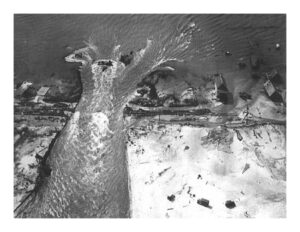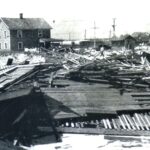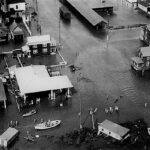
OCEAN CITY – If you ask any local to pinpoint the most significant event in Ocean City’s history, they will likely provide one answer – the storm of 1933.
That August, in the midst of the busy tourism season, hurricane-force winds, massive waves and severe rain battered the resort community, leaving in its wake an Inlet that forever changed the landscape of Ocean City.
In recognition of the 90th anniversary, local historians, businessmen and residents sat down with The Dispatch to talk about the historic storm that destroyed homes and businesses, wiped out the Boardwalk and railroad bridge, and paved the way for future development.
“This was, in my opinion, the most important event that ever happened in Ocean City’s history,” said local historian and author Bunk Mann.
Prior to 1933, the train brought many visitors to the small seasonal resort, and hotels and boarding houses extended to 15th Street, which at that time was the northernmost point in town. The southern end of Ocean City featured several commercial pound fishing camps, where the fresh catch was carted by horse from the surf to the island’s train station to be weighed, packed and shipped to metropolitan areas.
“The town actually went to about South 7th Street. All of that is under the Inlet today,” Mann said. “But there wasn’t anything down there except what they called the fish camps, which were the pound fishing camps. There was no Inlet. You had the bay, and you had the ocean, and the barrier island extended all the way down to Assateague and Chincoteague with no break.”
But all of that would soon change.
A tropical storm first appeared in meteorological records on Aug. 17, 1933. And by the following evening, it achieved hurricane status.
“In 1933, the weather forecasting was basically in its infancy, if even that …,” Mann said. “But this hurricane was coming.”
Rain and winds arrived in Ocean City on Aug. 19 and continued to batter the town for days afterward. By Aug. 21, more than 10 inches of rain had fallen, filling the back bays and tributaries to the point of overflowing.
While a voluntary evacuation had occurred, many rode out the storm in their homes. In Mann’s book, “Vanishing Ocean City,” several witnesses described the devastation that unfolded.
“The Storm of ‘33 was not a true hurricane – the winds never got over 65 mph – but it rained and blew for three days,” resident Alger “Tiny” Abbott Jr. said. “It never let up for three solid days and when it was over water was everywhere. There was just solid water from Herring Creek all the way to the ocean.”
David Bunting, whose family built the docks at Dorchester Street, told The Dispatch last month his father, Orlando Bunting, was operating a charter business when the 1933 storm hit. While he said the town had experienced previous flooding events, nothing had matched the severity of flooding that had occurred that August.
“My father’s boats, he cut them loose and let them float,” he said. “After it calmed down, they had to go out and get the boats back.”
In an interview last month, Debbie DeFressine, a museum aide for the Ocean City Life-Saving Station Museum, shared her family’s recollections of the storm. Her great-grandfather, Capt. Christopher Ludlam, who had introduced pound fishing to the resort in 1896, was living in Ocean City with his family when the storm struck.
“They lived on what is now the municipal parking lot between South Division and Worcester Street, in a Cape Cod home …,” she said. “When the storm first started, the floor looked like piano keys and the furniture was floating. After the water receded there were a lot of snakes.”
While Ocean City was spared the brunt of the storm, the surging tides and four straight days of rain caused water to break through the lowest spot in town, the pound fishing camps between South 4th and South 5th streets. And on Aug. 23, an inlet was formed.
“It really wiped out all the fishing camps,” DeFressine said. “All the properties and all that the Ludlams owned, the storm just destroyed it.”
Local attorney Hugh Cropper said his grandfather, Hugh T. Cropper, and great-grandfather, Hugh A. Cropper, were also present at the time of the storm.
“My grandfather reports they had a fish camp, fish business, there and that it was beyond devastating …,” he recalled. “He said hunting dogs washed into the ocean, horses washed into the ocean, buildings washed into the ocean. It was quick.”
He said despite some claims, it was not the ocean tides that formed the Inlet, but the bay.
“There were days and days of rain and storms and a hard northwest wind, and the tide and ocean dropped precipitously,” he said. “The water in the bay, which was at a much higher level, rushed through and opened up the Inlet.”
The idea of creating an inlet that would provide access from the bays to the Atlantic Ocean formed long before the 1933 storm. For years, Ocean City businessmen, understanding what ocean access could do for the resort, petitioned state and federal agencies to create a made-made inlet along the barrier island.
In the spring of 1933, for example, an Eastern Shore contingent led by Sen. Millard E. Tydings traveled to Washington to petition the Board of Engineers for Rivers and Harbors to fund the creation of an ocean-access inlet. A congressional bill, however, failed to pass before the legislative session ended. Months later, the storm would do what officials had failed to accomplish for decades.
“The town wanted the inlet for 20, 30 years but the state was worried it would fill with sand …,” Bunting said. “Once nature cut it, it stayed open.”
In September 1933, the U.S. Army Corps of Engineers began work to stabilize the newly created Inlet by building a jetty system. It would prove to be a catalyst for tourism and development in the decades that followed.
In West Ocean City, a commercial harbor sprang to life and countless marinas and docks formed to accommodate the ever-expanding sportfishing industry created in the wake of the storm.
“In terms of tourism, the lasting impact of the storm was immense,” said Susan Jones, executive director of the Ocean City Hotel-Motel-Restaurant Association. “Thankfully, our leaders at the time had the foresight to create a commercial fishing harbor, essentially building our town as a fishing haven. Fishing and tourism go hand in hand, fresh fish for restaurants, recreational fishing, sport fishing, commercial fishing, so many tourism tentacles.”

A former fish camp is pictured in ruins after the historic Storm of 1933. Photo courtesy of Bunk Mann
The 1933 storm also served as a catalyst for other changes in and around the resort. For example, the creation of the Inlet led to the widening of the beach at the south end of Ocean City, as sand drifting south began filling behind the new jetty system. And while the old railroad bridge that crossed from the mainland into the resort was obliterated by the 1933 storm, a new Route 50 bridge would be built less than nine years later, increasing visitor traffic and jumpstarting a tourism-related building boom.
“A few realized the treasure that had been given to them on August 23rd in the form of a new inlet and plans were quickly made to preserve it,” an excerpt from Mann’s book reads. “Because of the Great Depression and the coming interruptions in tourism due to World War II much of the benefit of this connection to the ocean would not be immediately realized. In time however it would do much to change a small seasonal resort and fishing village into a modern regional destination. Without the Inlet, Ocean City would be a much different place today.”



